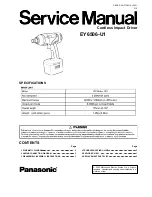
EN
- 9 -
3. Keep the battery charger, batteries and the
cordless tool out of children‘s reach.
4. Do not use damaged battery chargers.
5. Do not use the supplied battery charger to
charge other cordless tools.
6. In heavy use the battery pack will become
warm. Allow the battery pack to cool to room
temperature before commencing with the
charging.
7.
Do not over-charge batteries.
Do not
exceed the maximum charging times. These
charging times apply only to discharged
batteries. Frequent insertion of a charged
or partly charged battery pack will result in
over-charging and cell damage. Do not leave
batteries in the charger for more than 48
hours.
8.
Never use or charge batteries if you
suspect that the last time they were
charged was more than 12 months
previously.
There is a high probability
that the battery pack has already su
ff
ered
dangerous damage (exhaustive discharge).
9. Charging batteries at a temperature below
50°F (10°C) will cause chemical damage to
the cell and may cause a
fi
re.
10. Do not use batteries which have heated
during the charging process, as the battery
cells may have su
ff
ered dangerous damage.
11. Do not use batteries which have su
ff
ered
curvature or deformation during the charging
process or which show other non-typical
symptoms (gassing, hissing, cracking,…)
12. Never fully discharge the battery pack
(recommended depth of discharge max.
80%) A complete discharge of the battery
pack will lead to premature ageing of the
battery cells.
13. Never charge the batteries unsupervised.
Protection from environmental in
fl
uences
1. Wear suitable work clothes. Wear safety
goggles.
2.
Protect your cordless tool and the battery
charger from moisture and rain.
Moisture
and rain can cause dangerous cell damage.
3. Do not use the cordless tool or the battery
charger near vapors and in
fl
ammable liquids.
4. Use the battery charger and cordless tools
only in dry conditions and an ambient
temperature of 50°F to 104°F (10°C to 40°C).
5. Do not keep the battery charger in places
where the temperature is liable to reach over
104°F (40°C). In particular, do not leave the
battery charger in a car that is parked in the
sunshine.
6.
Protect batteries from overheating.
Overloads, over-charging and exposure to
direct sunlight will result in overheating and
cell damage. Never charge or work with
batteries which have been overheated –
replace them immediately if possible.
7.
Storage of batteries, battery chargers
and cordless tools.
Store the charger and
your cordless tool only in dry places with an
ambient temperature of 50°F to 104°F (10°C
to 40°C). Store the Lithium-Ion rechargeable
battery in a cool and dry place at 50°F to 68°F
(10°C to 20°C). Protect them from humidity
and direct sunlight! Place only fully charged
batteries in storage (charged at least 40%).
8. Prevent the Lithium-Ion battery pack from
freezing. Battery packs which were stored
below 32°F (0°C) for more than 60 minutes
must be disposed of.
9. When handling batteries beware of
electrostatic charge: Electrostatic discharges
cause damage of the electronic protection
system and the battery cells. Avoid
electrostatic charging and never touch the
battery poles.
Battery C Disposal
Disposal
Should your appliance need replacement after
extended use, do not dispose of it with the
household refuse, but in an environmentally safe
way.
Waste produced by electrical machine
items should not be handled like normal
household rubbish. Please recycle where
recycle facilities exist. Check with your local
authority or retailer for recycling advice.
Always dispose of your battery pack according
to federal, state, provincial and local regulations.
Contact a recycling agency in your area for recycling
locations.
CAUTION
! Even discharged battery packs
contain some energy. Before disposing, use
electrical tape to cover the terminals to prevent
the battery pack from shorting, which could cause
a
fi
re or explosion.
WARNING!
To reduce the risk of injury or
explosion, never burn or incinerate a battery
pack even if it is damaged, dead, or completely
discharged. When burned, toxic fumes and
materials are emitted into the surrounding
atmosphere.
Anl_TP_CI_18_Li_BL_SPK7_USA.indb 9
Anl_TP_CI_18_Li_BL_SPK7_USA.indb 9
02.05.2022 15:58:44
02.05.2022 15:58:44










































